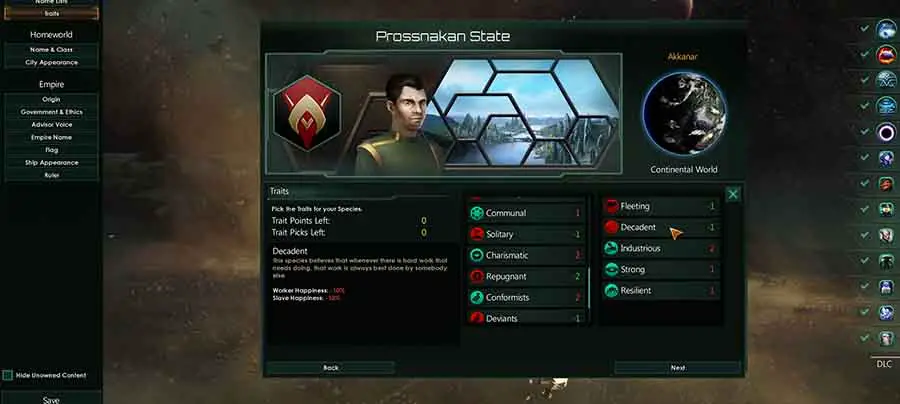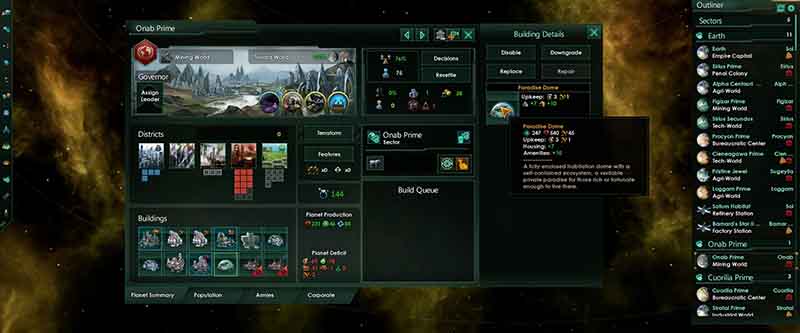
Traits are characteristics your civilization and leaders have. An empire’s traits are chosen during the game setup. Each standard empire has its own traits preset but they can be changed by editing the civilization prior to starting the game.
The best traits are traits that help each other, there are no real “best” ones due to differing playstyles. For a strong military choose something like Decadent, which reduces worker and slave happiness by 10% and Fleeting, which reduces leader life span by 10 years, then choose “positive” traits that boost combat or industrial strength.
Both of these disadvantages of Decadent and Fleeting can be offset through technologies and buildings, so these are not significant drawbacks. That gives me a total of 4 trait points to use. That would allow me to select Industrious, Strong and Resilient as positive empire traits, for example.
At the start of the game each empire gets 2 trait points and 5 trait picks before the game starts. The reason an empire gest more picks than points is because some traits are negative, which adds to the number of points that can be used. Selecting a trait with a red icon, like Fleeting, is a negative species trait that reduces your leader’s lifespan by 10 years, but it provides 3 trait points to use instead of 2. Choosing a trait with a green background is considered a positive trait and uses up 1 or more trait points, depending on the selected trait.
Industrious gives me an additional 15% output from Minerals jobs, Strong a 20% bonus in Army Damage and a 2.50% increase in all Worker resource outputs, and Resilient givens my defensive armies a 50% boost in damage.
Although you can’t choose what traits to give your leaders you do have some control by selecting leaders with the traits you want. You might choose a scientist with a 35% faster Anomaly Research Speed over a Scientist with Expertise in Material Research if you’re planning on assigning the Scientist to a Science ship.
There are lots of combinations that work, just decide what works best for your playstyle or goals for this particular game session.
Stellaris Unspent Civic Points
Unspent civic points places your empire at a disadvantage since each one has its own special bonuses. Stellaris Civics are the “principles of life” that your civilization follows. The default number of civics your empire starts with is two but that can be increased by researching the appropriate technology. They can be changed once every 20 years for a cost of 250 Influence points.
To use unpent civics point click on the “Unused Civics Point” alert at the top of the screen. Alternatively, click on the Government icon in the upper left corner of the screen. Both will take you to the Government screen.
Stellaris is not hard to learn, it is the easiest grand strategy game from Paradox to master.
At the Government screen click on “Reform Government.” This will take you to the Reform Government screen where you can change ethics. If you missed selecting your Civics during the game set up, they can still be selected after starting the game. The drawback is that you will still need to wait 20 years and pay 250 Influence to get them, even though they would have been free at the start of the game.
Most Civics have their own unique requirements, and all have their advantages. For instance, you could select the Cutthroat Politics Civic to reduce Edict costs by 20% and gain a point in Codebreaking with no restrictions. You could also choose a Civics like Free Haven, which is a society that welcomes all immigrants. In order to use that Civic your civilization has to be some type of Xenophile and it cannot have the Corvee System Civic.
Preferred Stellaris Government Type
Every empire has a government. You have no control over the Government name except by choosing Ethics, Civics, and Authority type, the game generates the name automatically based the selections you make at the beginning of the game.
There are two government types I find myself using most of the time, a Star Empire and a Representative Democracy, with my favorite being a Star Empire, which a cross between the Star Trek Romulan and Klingon Empires. As an Imperial ruler my empire gets an additional edict capacity of 1. I like Cutthroat Politics because it reduces the cost of my Edicts by 20%, which I tend to use a lot. I also like the Diplomatic Corps (think Romulans here, not Klingons) to get 2 additional Envoys for Espionage use. Since I planned for this empire to be warlike, I chose the Fanatic Militarist Ethic for the Influence cost claim reduction of 20% and an increased ship fire rate of 20%. The other ethic I liked was Authoritarian for the .50 bump in monthly Influence and the Worker resource output increase of 5%. One of my favorite customized empires to play in this game (The Terran State).
My other favorite is the Terran Confederacy (think Star Trek Federation), which is a Representative Democracy. To get this government type I chose the Xenophile ethic, mainly for the additional Envoy that it provides and increased trade value and the Fanatic Egalitarian Ethic, which gives me a 50% gain in Faction Influence and a bump of 10% in Specialist worker output. Since I wanted it to be Democratic, I chose the Democratic authority, which made it a Representative Democracy. I needed a couple of civics to add to my “Starfleet Federation” empire, so I took Beacon Of Liberty which holds liberty and individual freedom with the highest esteem and Idealistic Foundation which raises pop happiness by 5%.
Is Stellaris Easy To Learn?
Stellaris is a complex, space strategy game. It has lots of options, empires and other customizations that can get complicated. Does this make it hard to learn?
Stellaris is not hard to learn, it is the easiest grand strategy from Paradox to master. Game set up is easy and the game advisor walks you though the initial stages of the game. Pop up alerts at the top of the screen keep you on top of your empire’s needs.
There are a lot of complexities to learn but once you learn the research basics, exploration basics, and how to explore and exploit resources, the game will unfold by itself. While it won’t teach you all the detailed strategy you need to have, like combat and empire management, once you have the basics down, you’ll learn, sometimes through experimentation, what you need to do to balance things out, like building more Industrial Districts to reduce a shortage of consumer goods and alloys. Of course, in order to do that you’ll need a good supply of minerals. A very deep game with interwoven systems that you may never completely understand but it will be a lot of fun learning the complexities and mastering them.
If you want to learn the game plus have a victory the first time you play check out my Stellaris Best Settings page. It has some good tips on setting up an empire that is easy to play and setting up a game that will help you learn the game basics and succeed. It also has a few beginner tips. I also have a 101 Stellaris Tips page.
How To Win In Stellaris
The basic way to win in Stellaris is to have the highest score at the end of the victory year. Another way is to become the Crisis and take over the whole galaxy.
The victory year defaults to 2500 but before the game starts it can be adjusted all the way to the year 3200, going past that turns the timer off. The victory score is determined through a number of different stats.
Economic strength, technology level, the number of systems you own, the number of colonies you have, how many pops you have, subject empires, whether you belong to a Federation or not, how many crisis ships you kill and the number of relics collected all add to the total victory score. If you become the crisis you get the added bonus of having any star systems you destroy counting toward your total victory score.
If you become the Crisis then the other way to win is to kill everyone else off and claim the galaxy as your own.
A good beginner strategy is to not construct a huge fleet at the start of the game. Keep it small and build up the economy you need to support a large fleet, plus stockpile alloys. Develop planets that are close to you with good habitability, I usually go for a minimum of 80% but that might not always be available.
Build shipyards close to chokepoints and control those chokepoints. Don’t make war until you’re ready and then pick on someone who is not your own size.
Get tips on playing Stellaris at this page on my website.
How To Get Started With Stellaris
The best start for a beginner is to use a premade empire, one that is not overly aggressive like the United Nations of Earth. Use a small galaxy of 400 stars or less and set the galaxy type to elliptical. Don’t aggravate your neighbors too much at the start of the game and prepare for war but don’t initiate one until you’re ready.
I have a full article at this website describing the best starting settings for Stellaris and a good beginning strategy.
Stellaris Amenities

Amenities are the stuff that makes pops happy, like flat screen TVs and movies. Just like in real life, having a lot of amenities available makes people happier.
The best way to increase amenities empire-wide is to completely build a Mega Art Installation. This gives a 20% boost to amenities empire wide.
Since each planet get a 2% reduction in happiness for every amenity it is short of, one of the best ways to control that is through discouraging population growth, which is a decision that can be made on a planet-by-planet basis.
To get a view of your amenity supply go to a planet and click on the Planet Summary tab. In the upper right box, there is an icon for amenities. Hovering the mouse cursor over it will give a detailed breakdown of how you are gaining amenities and what they are being spent on. It will also tell you how much happiness is being affected by the amenities. If a planet’s happiness gets too low it will affect the stability and crime rate, causing lost production and potentially the loss of the planet.
Buildings can also help out with amenities. Luxury Residences produce 5 amenities per month and give the planet 4 more housing slots. Designed with the richer part of the populace in mind.
Building a Paradise Dome will increase amenities on a planet by 10, plus it will increase housing by 7. The cost to maintain it are 3 energy credits and 1 rare crystal per month. These domes are a private paradise for the rich.
By building a Galactic Stock Exchange you can increase amenities by 10 and bump up the planet’s trade value by 24. Upkeep is 5 energy credits and 1 rare crystal per month.
Holo-Theaters are cheap to maintain at only 2 energy credits per month and they produce 20 amenities per month. Entertainers transform consumer goods into 7 Unity and 20 Amenities per month at a cost of 2 Consumer Goods per month, so monitoring the influx and outflux of Consumer Goods is a good idea.
Gene Clinics can produce both Amenities and increase pop growth speed.
Commercial Zones will increase amenities by 6 and only cost 2 credit units per month to maintain. They also increase the trade value of the planet.
A Ministry of Production building provides 8 Amenities per month. Administrators in this building also produce Unity.
Stellaris Alloys
Alloys are the basic building material for ships, starbases and megastructures, having a large stockpile of these is a good idea in case an unexpected war breaks out. Having these available means you can build a fleet at the Shipyard closest to the combat, and it might even surprise your enemy by causing him to underestimate you due to a small fleet size that can be rapidly increased.
Alloys can be gained through mining, buildings and Industrial Districts. Ever since the 3.0 patch the only place where an Alloy Foundry can be built is at a Habitat. If you were playing a game prior to the update they will still be on your planets but you won’t be able to build any more. At an Alloy Foundry Metallurgists turn minerals into alloys.
The Alloy Foundries have been replaced by Industrial Districts. These districts provide a double benefit, Metallurgists still turn minerals into alloys, but Artisans also turn minerals into Consumer Goods, so these districts can put a strain on mineral resources. Each Artisan can produce 9 Consumer Goods and each metallurgist can produce 7 alloys. The upkeep for 1 job is 17 minerals and 1 energy credit.
Although rare, alloys can also be mined from uninhabitable planets by building a mining station above them. How many alloys you get depends on the richness of the planet.
Don’t forget to visit my YouTube channel at https://www.youtube.com/channel/UCcWU6qxVisK93h5guKRVtdg
There is also the Marketplace. If you can’t produce enough alloys and you have a surplus of other resources you can always go there to sell excess resources and buy the amount of alloys you need.

